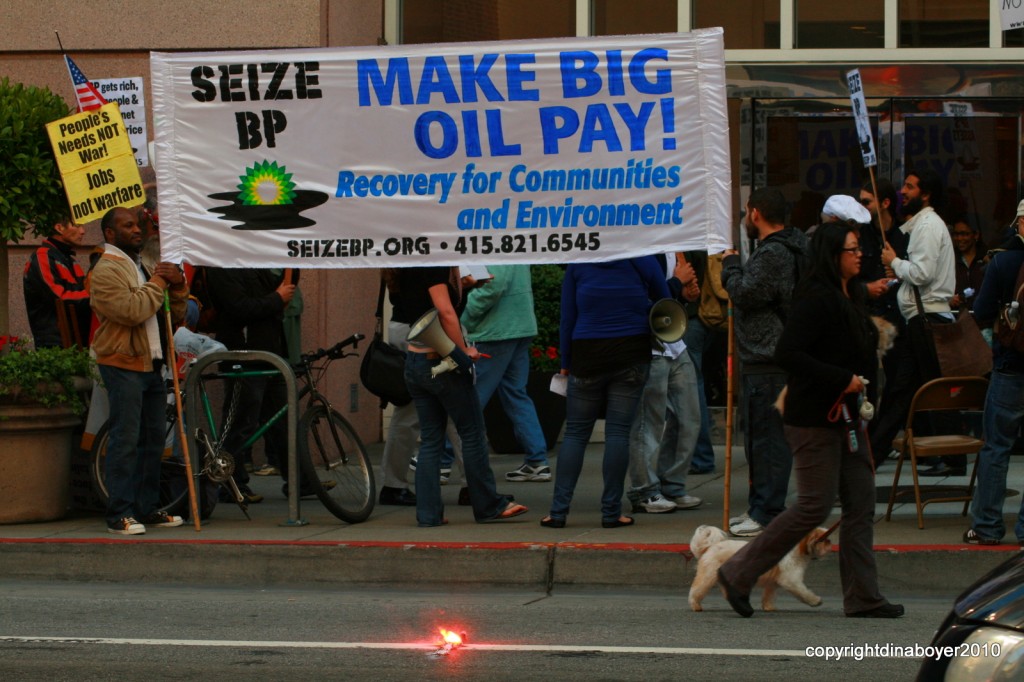
Pun level: 0.0 Rhyme level: 0.0 Scapegoating George W. Bush level: 0.0 All in all, a disappointing protest sign.
How many times could you fill the world’s largest supertanker with the oil that’s spilled since the Deepwater Horizon disaster began?
Come on, guess.
Okay, let’s make it multiple-choice. Is it:
- 20,000
- 100,000
- 600
- .2
The answer is 4), although that’s using the low estimate. At the absolute most, the oil that’s spilled so far would barely fill the TI Africa once.
Whoever says America’s education system is in shambles is wrong: in the last 7 weeks, we’ve become a nation of 300 million petroleum engineers. Still, that leaves the number of economists dangerously low.
British Petroleum is not evil. Joseph Stalin slaughtered people for the pleasure of it. O.J. Simpson too, on a smaller scale. The worst you can call BP is negligent, and even that implies that there’s no such thing as an unavoidable disaster.
11 BP employees died*, in case you forgot or never knew. Also, now is not a great time to be a shearwater. The human and animal costs notwithstanding, there remains an economic impact. If that sounds crass, denying the existence of said economic impact doesn’t make it any less real or eliminate the need to acknowledge and minimize it.
So let’s pretend that the people who are screaming that SOMETHING MUST BE DONE are willing to replace rhetoric with logic. Here are facts, not opinions:
- It’s not the worst spill in Gulf of Mexico history. (That’d be the Ixtoc I spill of 1979, which lasted 9 months.)
- It’s not the worst spill in American history. (Lakeview Gusher, California. 101 years ago. You’ve never heard of it, which should give you an idea of its lasting impact.)
- It’s not even close to the worst oil spill in world history: we can still thank Saddam Hussein for that. At least Deepwater Horizon wasn’t deliberate.
- Some people are convinced that there’s nothing the federal government can’t do.
- Wishing, even demanding, is never enough to solve a problem.
- BP stock has lost most of its value since the spill began, with a floor to be determined. (“Good! Teach those planet-rapers what’s what!”)
Voluntary exchanges of stock have already cost BP $97.9 billion, to say nothing of the costs involved in cleaning up the mess. If that’s not enough for you, what would be?
Seize their assets!
Their rapidly dwindling assets? To what end? So federal bureaucrats with zero accountability and zero experience can manage those assets? Never mind that BP, as its acronym would indicate, is headquartered in the United Kingdom and harder for the federal government to claim than, say, General Motors.
Wiping BP from the face of the earth would make a bad situation worse. BP has created 92,000 jobs around the world without requiring taxation or a confiscatory stimulus package to do so. Is employment important?
And if BP went broke, then what?
Bankruptcy court!
According to its 2008 balance sheet, BP has $228 billion in assets including $103 billion in “hard” assets – property, plant, equipment etc. Those would go to the highest bidder. Which would be a company that has not only a use for supertankers, rigs, and a distribution network, but the wherewithal to bid for them. Someone like, say, ExxonMobil. Yes, let’s increase the market share of the only company that environmentalists hate more than Amalgamated Lead Paint & Plastic Grocery Bags, Inc.
Solar and wind!
It’ll take more than a blog post to expose the holes in that argument, but for now, there’s no denser and more efficient way to transport potential energy than via petroleum and its derivatives. If there is, whoever discovered it is keeping awfully quiet and must hate money.
Perhaps it makes you feel good to join the “Boycott BP” Facebook group, even though all the BP stations in the United States are owned by franchisees. If you organize a protest, or pull an Ashton Kutcher and draw a connection between an oil spill and a political convention, think about what that does as far as solving the problem.
BP wants to stop and clean up the Deepwater Horizon spill a lot more than you do, so much so that they’re actually putting workers on the job. The next Code Pink volunteer who helps to float a containment boom up the Mississippi Delta will be the first.
Unless you’ve attempted to cap a drilling rig – one under a mile of water – you almost certainly don’t know if BP management is doing a good job or not.
They’re working on it. Sorry if that’s an unsatisfactory answer, but sometimes unfortunate events happen, and maybe laying blame is less important than solving the problem.
Any man-made disaster is like this. Exactly what are you supposed to do with the benefit of hindsight? If doctors didn’t prescribe thalidomide for pregnant women from 1957 through 1961, thousands of babies wouldn’t have been born with deformities. If a series of bureaucrats at the Federal Aviation Administration had refused to prohibit commercial pilots from carrying firearms, the World Trade Center would still be standing, 2743 civilians wouldn’t have been murdered, and there would have been less cause to invade Afghanistan and Iraq.
To write about Deepwater Horizon and say anything other than “hang BP’s CEO by his thumbs” might not be judicious, but there is a larger point. The stock is trading at a 13-year low. (Which might be a great buying opportunity. See here.) President Obama can show all the grave concern he wants. He can temporarily move the White House to Gulfport, Mississippi: it won’t stop the flow of oil. Nor will tarring and feathering BP chief Tony Hayward, to coin a phrase.
Righteous anger works fine when you punch out the guy who slapped your girlfriend. It works horribly with problems that are harder to fix. It takes composure, reason and hard science to make the Gulf of Mexico livable. If you can’t offer any of that, at least get out of the way.
——-
* Adam Weise, Dale Burkeen, Don Clark, Roy Kemp, Jason Anderson, Steve Curtis, Gordon Jones, Blair Manuel, Dewey Revette, Karl Kleppinger and Shane Roshto.





